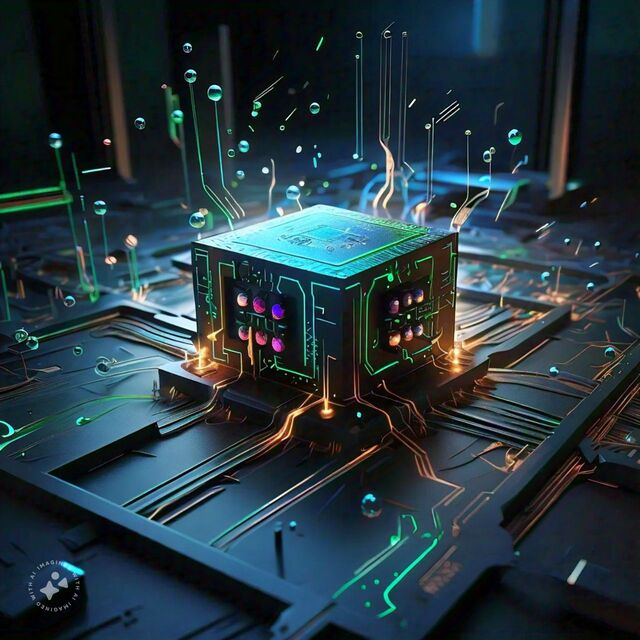Quantum computing, once a distant aspiration, is steadily becoming an existence, and current innovations are proving that we’re closer than ever to unlocking its complete potential. The latest milestone? The formation of the Logical Qubit is related to the revolution that is a step forward in the world of quantum technology. Through a partnership between Microsoft and Quantinuum, the birth of this far more steady and dependable quantum bit indicates a crucial moment in the competition toward functional, error-free quantum computers. But what exactly is a Reasonable Quantum bit, and why is this such a game-changer? In this post, we’ll disrupt the science behind the innovation, explain its importance, and investigate the future possibilities that arise from this exceptional achievement.
What is a Quantum bit, and Why is It Important?
Before diving into the specifics of reasonable quantum bits, let’s quickly revisit the concept of quantum computing and how it varies from classical computing. In ordinary machines, data is processed using units in one of two states: 0 or 1. Quantum computers, however, use qubits (short for quantum bits). Unlike classical units, quantum bits can exist as 0, 1, or both simultaneously due to an occurrence known as superposition. Quantum machines can process exponentially larger data than classical systems, making them incredibly powerful for solving definite issues, especially complicated calculations. However, quantum bits have a noteworthy drawback: they are fragile and prone to errors. Even the slightest interference can cause a quantum bit to forfeit its state, interrupting the quantum calculations. This fragility is the main barrier holding quantum computing from achieving prevalent functional use. This is where the logical qubit joins the picture.
What is a Reasonable Qubit?
A logical qubit aggregates physical qubits grouped in a method compensating for errors. The objective of the reasonable quantum bit is to reduce the likelihood of mistakes, making it more steady and dependable than a single physical qubit. Combining physical quantum bits into a reasonable quantum bit allows quantum machines to manage complicated calculations with fewer errors, a crucial element necessary for functional quantum applications.
Microsoft and Quantinuum’s Partnership: A Quantum Leap Forward
In recent months, Microsoft and Quantinuum have been working together to develop more dependable quantum bits using Microsoft’s sophisticated Qubit Virtualization System and Quantinuum’s H-Series Ion Trap Qubits. Ion trap technology employs ions, charged atoms held in location by electric fields, to create qubits. Combined, These two technologies resulted in the formation of reasonable quantum bits that are more dependable than any of their predecessors. The importance of this development cannot be overstated. Logical qubits allow quantum machines to perform complicated calculations without noteworthy errors. Without error correction, the functional application of quantum computing in domains such as drug discovery, material science, and artificial intelligence would remain out of reach.
A Breakthrough in Error Reduction
Microsoft and Quantinuum didn’t stop at merely creating reasonable qubits—they pushed the boundaries of error correction to unmatched levels. Their partnership initially yielded four reasonable quantum bits using 30 physical qubits. These reasonable quantum bits exhibited an error rate 800 times lower than the physical qubits. But they didn’t stop there. Microsoft and Quantinuum continued their work, achieving 12 reasonable qubits using 56 physical qubits. Even more remarkable is the degree of accuracy they reached. The accuracy of their two-qubit activities reached an astonishing 99.8%, meaning that nearly all activities were performed without errors. This accomplishment is historic because quantum computing, to be truly beneficial, requires quantum bits that are highly dependable and stable. The lower the error rate, the closer to fault-tolerant quantum computing, a condition where quantum machines can operate efficiently even when some quantum bits malfunction.
The Importance of Interconnectedness
In addition to improving the reliability of quantum bits, Microsoft and Quantinuum achieved something equally impressive: they demonstrated the entanglement of reasonable qubits. Interconnectedness is a distinct attribute in quantum physics where the condition of one quantum bit can instantly influence the condition of another regardless of distance. This attribute is a crucial element factor that makes quantum computing so powerful. The groups used a sophisticated interconnectedness technique known as the Greenberger-Horne-Zeilinger (GHZ) state, which involves simultaneously entangled multiple quantum bits. The complexity of this approach far surpasses the easier interconnectedness methods used in previous experiments. Despite the challenges, they achieved this interconnectedness with a remarkably minimal error rate of just 0.0011. To put that into viewpoint, the error rate of single physical quantum bits is typically 0.024, meaning the reasonable quantum bits were significantly more accurate. This minimal error rate delivers us closer to a world where quantum machines can tackle real-world issues such as simulating compounds for drug discovery, optimizing substances for sophisticated technologies, and improving safe communications.
A Hybrid Approach: Quantum and Classical Computing
While these outcomes are groundbreaking, Microsoft and Quantinuum’s work hasn’t yet achieved Quantum Advantage, which is the position where quantum machines outperform classical machines across the board. However, their hybrid approach of combining quantum and classical computing shows that quantum technology is already proving precious for particular issues, particularly in chemical computations. For instance, classical machines struggle with modeling the conduct of compounds at the quantum degree, which requires immense computing power. Quantum machines, on the other hand, can process these complicated issues with superior accuracy, making them indispensable in regions like drug discovery and material science.
What’s Next for Microsoft’s Azure Quantum Platform?
Microsoft has large strategies for its Azure Quantum framework, which it believes will be the future of quantum computing. The company aims to expand the framework to fully support different categories of quantum bits, including neutral particle qubits and topological qubits. Unbiased particle quantum bits controlled by lasers are highly effective for building large-scale quantum systems. In contrast, related to topology, quantum bits are designed to be more steady and less prone to errors, a quality fundamental for creating fault-tolerant quantum computers. Microsoft’s commitment to improving the scalability and reliability of quantum machines shows that the future is bright. With the possibility to revolutionize sectors such as healthcare, energy, climate science, and cryptography, quantum machines could soon tackle the world’s most complicated challenges.

Conclusion: A Quantum Revolution
The formation of the reasonable quantum bit by Microsoft and Quantinuum is a historic accomplishment in quantum computing. This breakthrough brings us closer to when quantum machines can solve issues that today’s classical machines cannot handle. With error speeds shrinking and quantum bit accuracy increasing, the aspiration of fault-tolerant quantum computing is becoming a reality. One object is clear as we look to the future: quantum computing is set to change the world. The partnership between Microsoft and Quantinuum represents not just technical progress but a step toward a novel age of computing.
What do you ponder about this breakthrough? Share your ideas in the comments, and don’t forget to subscribe for more updates on the exciting world of quantum technology!

The Best Gaming Laptops to Buy Right Now: Comprehensive 2024 Guide
Discover the best gaming laptops in 2024, from budget-friendly options to premium picks, with our complete guide covering key features, ...

Understanding Life Insurance Rate Charts by Age: What You Need to Know
This blog post explores the importance of life insurance rate charts by age, highlighting their benefits and providing practical tips ...

Top Smart Rings of 2024: Features, Benefits, and Future Trends in Wearable Tech
Discover the top smart rings of 2024, including the Oura Ring, Ultrahuman, and RingConn, and see how wearable tech is ...

Top 10 Budget Gaming Smartphones Under $1000: Ultimate Power
Discover the ultimate list of the top 10 gaming smartphones under $1000. Detailed reviews, specs, and comparisons to help you ...

The Best Gaming Laptops to Buy Right Now: Comprehensive 2024 Guide

Understanding Life Insurance Rate Charts by Age: What You Need to Know

Top Smart Rings of 2024: Features, Benefits, and Future Trends in Wearable Tech




